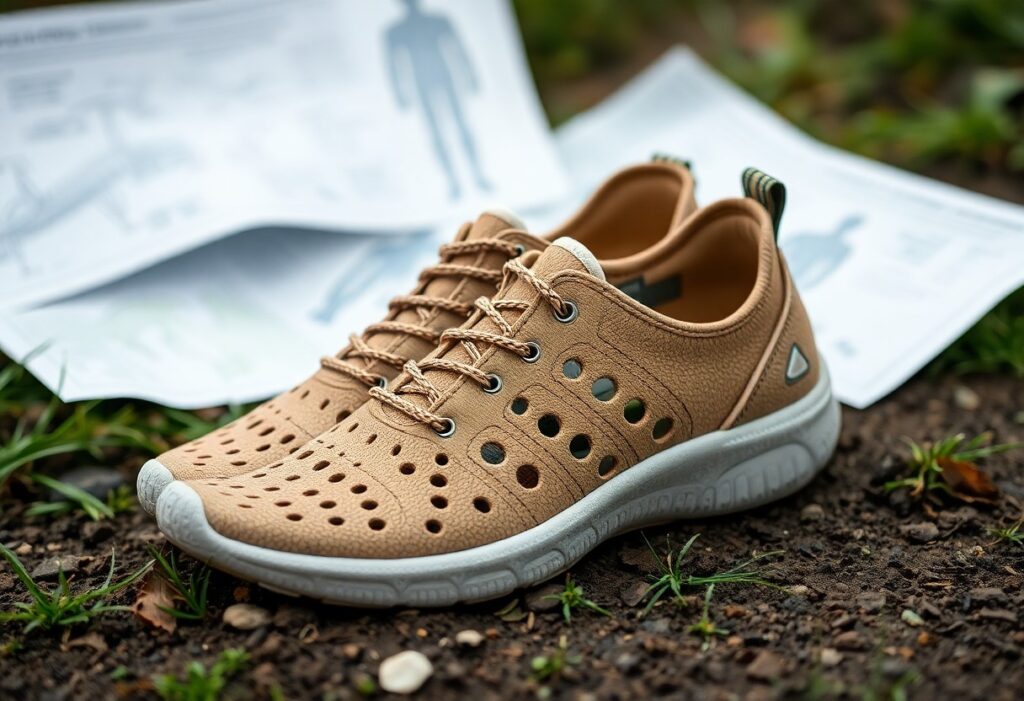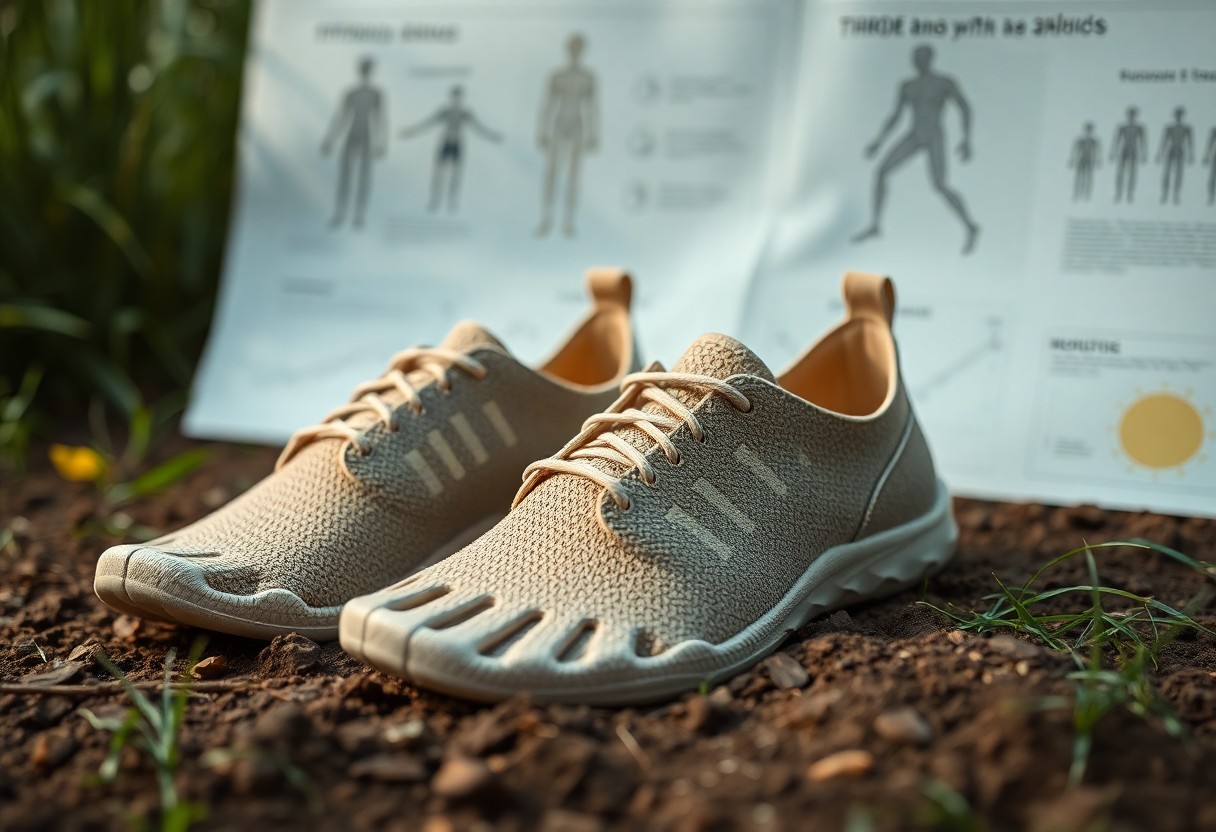
Sustainable design in footwear does more than reduce waste; it also enhances your foot health. Barefoot shoes are revolutionizing the industry by minimizing CO₂ emissions through innovative materials and manufacturing processes. By opting for these designs, you contribute to a future where biomechanical optimization aligns with environmental responsibility. Join the movement towards footwear that supports both your body and the planet, as lifecycle assessments show how minimalist models can significantly lower your carbon footprint.
Environmental Impact: Rethinking Footwear Production
Redefining footwear production requires innovative approaches to mitigate the environmental footprint. As the industry’s contributions to global CO₂ emissions are substantial, it is imperative to transition towards sustainable practices that prioritize both ecological balance and consumer health. By implementing advanced material sourcing, increasing manufacturing efficiency, and developing effective end-of-life management strategies, the footwear industry can make significant strides in reducing its carbon footprint.
Disruptive Material Innovations: Sourcing for Sustainability
Progressive brands are embracing disruptive material innovations to dramatically lower their environmental impact. For instance, Xero Shoes’ commitment to using hemp and recycled PET not only reduces production emissions by 32% but also aligns with consumer demand for sustainable materials. This shift not only supports local ecosystems but also promotes a circular economy by minimizing waste in the production process.
Lifecycle Analysis: Evaluating Carbon Footprint Reduction
Conducting thorough lifecycle analysis is vital for evaluating the overall carbon footprint of footwear. By assessing each stage—from material sourcing and manufacturing to usage and disposal—you can identify critical areas for improvement. For instance, the average emissions for barefoot shoes range from 10-20 kg CO₂e per pair, which is 40% lower than traditional athletic footwear. Identifying practices, like Vivobarefoot’s ReVivo initiative, which extends shoe lifespans and reduces emissions to 5.8 kg CO₂e, demonstrates the positive impact of sustainability measures on overall production effectiveness and consumer appeal.
The Synergy of Biomechanics and Barefoot Design
The integration of biomechanics within barefoot shoe design amplifies the benefits of minimalist footwear, enhancing both foot health and sustainability. By prioritizing natural foot movement, these shoes allow your foot to function as intended, leading to improved posture and reduced injury risk. The lightweight structures of barefoot shoes promote a more efficient gait, which not only feels better but is also less taxing on your body, making every step count toward personal and ecological well-being.
Optimizing Gait: How Minimalism Enhances Movement
Minimalist designs in barefoot shoes promote a natural gait, encouraging a midfoot or forefoot striking pattern. This shift can lead to a decreased impact force on joints, fostering a more efficient and comfortable walking or running experience. By removing excessive cushioning and support, the shoes allow your foot muscles to engage more fully, strengthening the intrinsic musculature necessary for optimal movement.
Energy Efficiency in Motion: Scientific Insights
Recent studies underscore the significance of energy efficiency in barefoot shoe performance. Research shows that runners in barefoot footwear experience a notable improvement in energy return and propulsion mechanics. This translates to less fatigue and a more sustainable running style, directly benefiting your movement efficiency during extended activities.
Enhanced energy efficiency is rooted in the design elements of barefoot shoes, which foster better biomechanics. For instance, 15-subject trials demonstrated that those wearing minimalist shoes reported an energy return rate of 89% when using algae-foam materials compared to 82% in traditional EVA foams. Additionally, the dynamic nature of barefoot footwear enables a more natural range of motion, significantly reducing knee loads during activities. By harnessing these benefits, barefoot shoes stand out as not only an environmentally friendly option but also as an innovative solution to achieving optimal energy efficiency in movement.

Consumer Motivations: The Drive for Sustainable Choices
Understanding consumer motivations is pivotal for driving the adoption of sustainable footwear. Today’s buyers are increasingly prioritizing ecological and health benefits, gravitating toward products that not only serve their functional needs but also align with personal values regarding environmental responsibility and wellbeing.
The Emerging Eco-Conscious Buyer: Trends and Preferences
As sustainability becomes a core value, eco-conscious consumers actively seek footwear brands that reflect these principles. Recent data indicate that 43% of shoppers are willing to pay a premium of 30% for sustainably produced shoes, highlighting a significant shift in consumer priorities towards eco-friendly materials and practices.
Perceived Value: Why Sustainability Matters
Value perception surrounding sustainability in footwear is more than just a trend; it’s foundational to purchasing decisions. You are likely influenced by environmental concerns, health benefits, and durability guarantees, with studies showing that perceived environmental benefit scores highest among consumer motivations.
When you choose sustainable footwear, you’re not just making a purchase; you’re supporting a movement towards responsible consumption. Strong sentiments surrounding environmental impact highlight that buyers appreciate brands prioritizing sustainable features. This perception of value translates to stronger brand loyalty and can amplify your choice’s impact, motivating manufacturers to invest in greener production methods and materials. In essence, sustainability elevates the perceived worth of a product, aligning your choices with greater environmental goals while also addressing your footwear needs.
Regulatory Landscape: Shaping the Future of Footwear
The evolving regulatory landscape is pivotal in steering the footwear industry towards sustainable innovation. With increasing scrutiny on carbon emissions and environmental degradation, regulations are being established to promote greener practices within manufacturing processes. Complying with these new mandates not only addresses environmental concerns but also aligns with consumer expectations, pushing brands to innovate responsibly and transparently.
Compliance Mandates: The Push for Sustainable Practices
Emerging compliance mandates, particularly in the EU, are setting the stage for sustainable practices within the footwear industry. By 2027, regulations will require a minimum of 20% recycled content in footwear materials, while by 2026, carbon labeling will be mandatory for all athletic shoes. These guidelines compel brands to rethink their material sourcing, production processes, and end-of-life strategies, ensuring greater accountability and environmental stewardship.
Innovation Through Regulation: Opportunities and Challenges
While new regulations present challenges, they also unlock opportunities for innovation. Adapting to compliance mandates drives brands to invest in sustainable technologies, creating solutions that reduce carbon footprints while enhancing product performance. For instance, companies are exploring biodegradable materials and advanced manufacturing techniques, which can lead to improved durability and reduced waste. However, navigating the complexities of regulatory compliance requires an agile approach, as organizations must balance sustainability goals with market demands and cost considerations.
In light of these challenges, the regulatory landscape fosters a culture of innovation that incentivizes new materials and processes. Adopting technologies such as 3D printing and biobased materials not only aligns with compliance requirements but also offers unique branding opportunities that resonate with environmentally conscious consumers. Brands willing to embrace these transformative changes can differentiate themselves in a competitive market, driving progress while simultaneously adhering to rigorous environmental standards. By viewing regulation as an opportunity rather than a hurdle, you can position your brand at the forefront of the sustainable footwear movement.
The Future of Footwear: Technology and Sustainability
The convergence of technology and sustainability is redefining footwear as you know it. As manufacturers leverage advanced materials and smart features, the next generation of shoes promises enhanced performance while minimizing environmental impact. Innovations like 3D printing and smart systems are paving the way for designs that not only cater to your foot health needs but also promote ecological integrity. This dynamic shift reflects a growing commitment to marrying functionality with environmental responsibility.
Smart Features in Footwear: Bridging User Experience and Ecology
Smart features in footwear enhance your experience while contributing to sustainability. Through the integration of sensors, shoes can provide real-time feedback on your gait, helping you optimize your performance and reduce injury risk. Additionally, these innovations often utilize eco-friendly materials, ensuring that your pursuit of athleticism aligns with your desire to protect the environment.
On-Demand Production: The Role of Customization and 3D Printing
On-demand production harnesses 3D printing technology to create shoes tailored specifically to your needs. This approach not only allows for customized fit but also significantly reduces waste associated with traditional manufacturing processes.
By utilizing advanced 3D printing methods, brands can produce footwear that precisely matches individual foot dimensions based on pressure mapping and other biometric data. This customization minimizes the likelihood of returns and excess inventory, with studies showing a 73% reduction in waste through on-demand manufacturing practices. Furthermore, production can be localized, decreasing transportation emissions and bolstering regional economies. As brands embrace this technology, you benefit from shoes that are not only better suited to your feet but also environmentally responsible.
Summing up
As a reminder, sustainable footwear innovation is transforming the industry by aligning biomechanics with environmental responsibility in barefoot shoe design. You can enhance your foot health while significantly reducing your carbon footprint through the adoption of minimalist footwear. By choosing shoes that prioritize sustainable materials and manufacturing practices, you support a shift towards a more eco-conscious market. Embracing these advancements not only benefits you personally but also contributes to the broader goal of planetary wellbeing, promoting a future where function and sustainability walk hand in hand.








Your insights on sustainable footwear are compelling, especially the link between minimalist designs and foot health. However, it raises a critical question: can the movement toward such sustainable practices create a shift in consumer priorities? Many still gravitate towards flashy, high-performance brands despite the detrimental impacts on the environment.
It’s refreshing to see a blog post that so clearly connects the dots between sustainable design and personal well-being, particularly within the realm of footwear. The notion that our choices in what we wear on our feet can have such a profound impact on both our health and the health of our planet is a powerful reminder of the interconnectedness of our actions.
It’s inspiring to see the shift towards sustainable footwear design, especially with the emergence of barefoot shoes. I’ve personally made the switch to minimalist footwear over the past year, and I’ve noticed not just a positive change in my foot health but also a growing awareness of the role my choices play in environmental sustainability. The connection between comfort, health, and ecological consciousness is becoming increasingly clear.
As someone who has recently transitioned to barefoot shoes, I can attest to the profound difference they make not just for foot health, but also in terms of mindfulness about our consumption choices. It’s fascinating how the minimalist design can encourage a more natural gait, ultimately reducing injury risk while aligning with sustainability principles.
It’s really fascinating to see how sustainable footwear is making waves—not just for the planet but for our health too! I recently made the switch to barefoot shoes, and honestly, the difference in comfort and support has been eye-opening. It’s like my feet finally get a chance to breathe and move naturally.
It’s refreshing to see discussions on sustainable design in footwear, especially the emphasis on barefoot shoes and their innovative approaches to both health and environmental stewardship. I’ve been exploring the transition to more sustainable footwear in my own life, and I’ve noticed how much our choices in this area can influence not just our personal well-being but also the larger ecological picture.
It’s refreshing to see the conversation around sustainable footwear evolving, especially with the rise of barefoot shoes. I’ve personally experienced the benefits of minimalist designs—not only do they reduce waste, but they also promote a more natural gait that feels better for my feet and overall posture. There’s something quite liberating about being able to feel the ground beneath you while knowing that your choice is also supporting environmental initiatives.
I love how you highlight the connection between sustainable footwear and foot health! I’ve recently shifted to barefoot shoes myself, and I’ve noticed a positive change in how my feet feel throughout the day. It’s fascinating to see how mindful design can influence our biomechanics while also caring for the planet.
It’s inspiring to see how the intersection of footwear design and sustainability can lead to healthier choices for both our feet and the planet. I’ve recently switched to barefoot shoes myself, and I’ve felt a genuine difference in comfort and mobility. It’s fascinating to consider how much of an impact innovation in materials can have, not just on our daily lives but on the global environment as a whole.
Your insights on sustainable footwear are truly thought-provoking. As someone who has recently transitioned to barefoot shoes, I’ve noticed not only the benefits for my foot health but also the sense of connection to the environment that comes with choosing eco-friendly options. It’s fascinating to see how the choice of materials can significantly impact our ecological footprint while enhancing our biomechanics.
I love the direction this is heading! It’s almost like our feet are getting their own eco-friendly spa day while saving the planet. Who knew a pair of shoes could be both a fashion statement and a carbon-fighting superhero?
It’s fascinating to see how barefoot shoes are making waves not only for foot health but also for sustainability. I recently switched to minimalist footwear, and I’ve noticed a significant improvement in my posture and overall comfort. It’s a win-win when our choices benefit both our bodies and the environment.
Your insights on sustainable footwear truly resonate with the ongoing dialogue surrounding eco-conscious living and personal well-being. It’s refreshing to see how the evolution of barefoot shoes encapsulates not only a shift in design philosophy but also a fundamental change in how we perceive our relationship with the environment.
Your exploration of sustainable footwear design resonates deeply with the broader shift we are witnessing in consumer habits and environmental consciousness. The dual benefit of supporting our foot health while simultaneously making eco-friendly choices is particularly compelling. I’ve recently transitioned to barefoot shoes myself, and the difference in comfort and posture has been remarkable. It’s interesting to see how this shift towards minimalist footwear not only promotes better biomechanics but also aligns beautifully with our collective responsibility to the planet.
It’s interesting to see how the conversation around sustainable footwear is evolving, particularly with the rise of barefoot shoes. While I’m fully on board with the idea that reducing waste and lowering our carbon footprint is critical, I can’t help but wonder about the potential trade-offs. For instance, while minimalist footwear can enhance foot health by promoting natural movement, there’s a concern that not everyone can easily transition to these styles without adjustments or adaptations to how they walk and run.